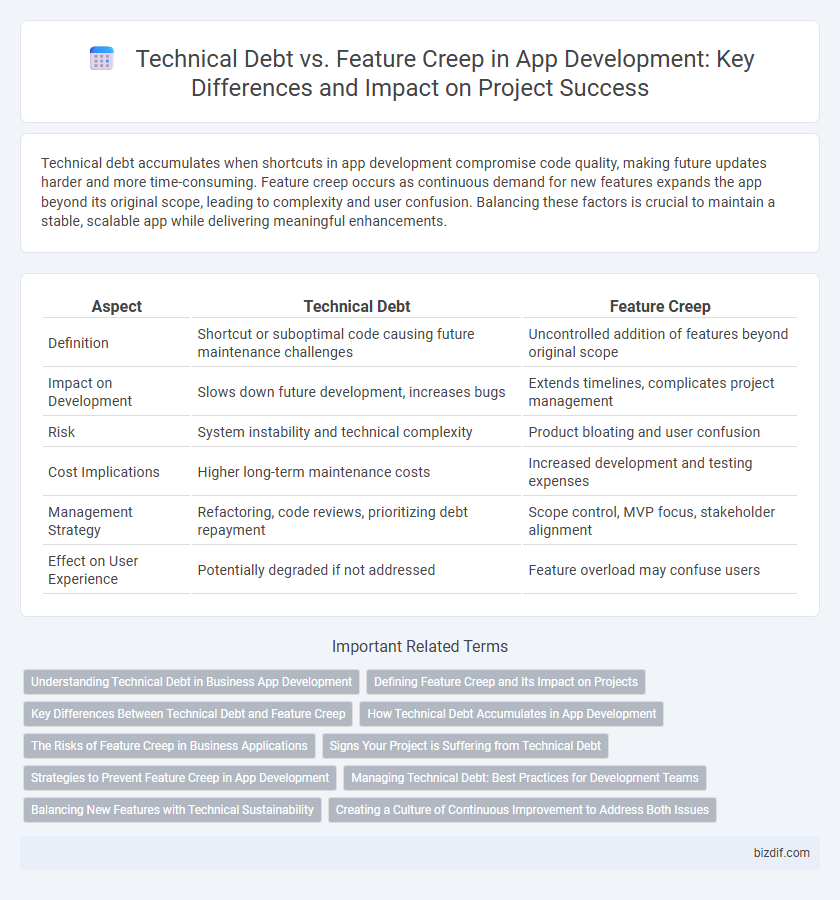Technical debt accumulates when shortcuts in app development compromise code quality, making future updates harder and more time-consuming. Feature creep occurs as continuous demand for new features expands the app beyond its original scope, leading to complexity and user confusion. Balancing these factors is crucial to maintain a stable, scalable app while delivering meaningful enhancements.
Table of Comparison
| Aspect | Technical Debt | Feature Creep |
|---|---|---|
| Definition | Shortcut or suboptimal code causing future maintenance challenges | Uncontrolled addition of features beyond original scope |
| Impact on Development | Slows down future development, increases bugs | Extends timelines, complicates project management |
| Risk | System instability and technical complexity | Product bloating and user confusion |
| Cost Implications | Higher long-term maintenance costs | Increased development and testing expenses |
| Management Strategy | Refactoring, code reviews, prioritizing debt repayment | Scope control, MVP focus, stakeholder alignment |
| Effect on User Experience | Potentially degraded if not addressed | Feature overload may confuse users |
Understanding Technical Debt in Business App Development
Technical debt in business app development refers to the accumulated cost of shortcuts or suboptimal coding choices made to expedite delivery, which can hinder future scalability and maintenance. Ignoring technical debt often results in increased bugs, slower development cycles, and higher long-term expenses. Properly managing technical debt ensures sustainable app performance and facilitates continuous feature integration without compromising quality.
Defining Feature Creep and Its Impact on Projects
Feature creep refers to the continuous expansion of a product's features beyond the original scope, often driven by customer demands or competitive pressure. This uncontrolled growth can lead to increased complexity, longer development times, and higher maintenance costs for app development projects. Managing feature creep effectively is crucial to maintaining project timelines, ensuring product quality, and controlling technical debt accumulation.
Key Differences Between Technical Debt and Feature Creep
Technical debt refers to the accumulation of suboptimal code or shortcuts taken during app development to meet deadlines, which can lead to increased maintenance costs and reduced performance over time. Feature creep involves the continuous addition of new features beyond the original scope, often resulting in bloated applications and delayed releases. The key difference lies in technical debt impacting code quality and system sustainability, while feature creep affects product scope and usability.
How Technical Debt Accumulates in App Development
Technical debt accumulates in app development through shortcuts taken to meet tight deadlines, resulting in compromised code quality and insufficient documentation. Frequent changes without proper refactoring, reliance on outdated libraries, and skipping automated testing also contribute to mounting technical debt. Over time, these factors lead to increased maintenance costs, slower feature delivery, and reduced application scalability.
The Risks of Feature Creep in Business Applications
Feature creep in business applications leads to bloated software, causing increased maintenance costs and slower performance. Excessive features often confuse users, reducing overall usability and satisfaction. This uncontrolled expansion undermines project timelines and escalates technical debt, threatening long-term application stability.
Signs Your Project is Suffering from Technical Debt
Frequent bugs, slow performance, and increased development time are clear signs your app project is suffering from technical debt. Code complexity and lack of documentation hinder new feature implementation, causing escalating maintenance costs. Ignoring these symptoms leads to stagnant progress and increased risk of project failure in app development.
Strategies to Prevent Feature Creep in App Development
Implementing clear project scope definitions and adhering to a prioritized feature backlog effectively prevents feature creep in app development. Regular stakeholder communication combined with iterative development cycles ensures that only essential functionalities are included, minimizing technical debt accumulation. Utilizing tools like agile methodologies and product management software enhances focus on delivering core value without unnecessary feature expansion.
Managing Technical Debt: Best Practices for Development Teams
Managing technical debt effectively requires continuous code refactoring and comprehensive documentation to maintain code quality and reduce future maintenance costs. Implementing automated testing and regular code reviews helps detect and address debt early, preventing feature creep from inflating complexity. Prioritizing clear communication among development teams ensures alignment on feature scope, minimizing unnecessary additions that contribute to both technical debt and delayed releases.
Balancing New Features with Technical Sustainability
Balancing new features with technical sustainability requires managing technical debt to avoid compromising code quality and long-term maintainability. Feature creep often leads to rushed implementations and increased complexity, amplifying technical debt and reducing development velocity. Prioritizing scalable architecture and regular refactoring ensures continuous innovation without sacrificing system stability or performance.
Creating a Culture of Continuous Improvement to Address Both Issues
Creating a culture of continuous improvement in app development involves regularly evaluating technical debt and feature creep to maintain a balanced product roadmap. Implementing disciplined code reviews, automated testing, and incremental refactoring reduces technical debt while preventing unnecessary feature bloat through prioritization frameworks like MoSCoW. Encouraging cross-functional collaboration and transparent communication aligns development teams around delivering sustainable, high-quality applications that evolve without compromising maintainability or user experience.
Technical Debt vs Feature Creep Infographic

 bizdif.com
bizdif.com